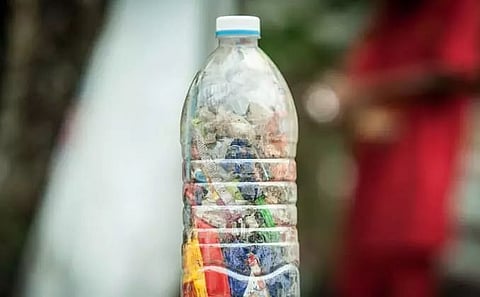Plastic, eco-bricks and environment
Partha Pratim Mazumder
(The writer can be reached at parthapratimmazumder1988@gmail.com)
Like much of the world, India is struggling to dispose its growing quantities of plastic waste given how ubiquitous it has become — from our tooth brushes to debit cards. India generates close to 26,000 tonnes of plastic a day, according to a CPCB (Central Pollution Control Board) estimate from 2012. Worse, a little over 10,000 tonnes a day of plastic waste remains uncollected. In 2050, the amount of plastic in seas and oceans across the world will weigh more than the fishes. The Indian culture has long held a deep connection with environment. But we have become apathetic nowadays. We have to decide if we want to be part of the problem or the solution? Saving the planet is a priority for most of us. Becoming less wasteful is a challenge.
The eco-bricks movement has gathered momentum over the last few years as plastic pollution has made phenomenal global headlines. Eco-bricks prevent plastic waste from disrupting the ecosystem and create an ecological consciousness against plastic. It saves the earth from being infertile. It reduces the cost of manpower and the usage of machinery. We can easily request everyone for making eco-bricks because there is no cost price of raw materials. It has become an increasingly popular material to build with, especially in developing countries, as plastic is exceptionally easy to come across at home or littered in the streets. Nowadays various districts of Assam, labourers are continuously making walls through eco-bricks. Creating homes from plastic waste and natural materials is smart. Plastics are sturdy and will stand the test of time, and they can be used over and over again for decades to come. Using natural building materials as opposed to cement also ensures that the bricks can be extricated undamaged, should the building be taken down. From home to chair to sculpted work of art the whole premise of up-cycling plastic to form useful products is inherently sustainable.
Plastics take very long to break down and they usually don't break down into liquid form but as smaller solids, called micro-plastics. Nobody really knows how long it takes for plastic to break down into its chemical compounds—it could be hundreds or thousands of years. Micro-plastics can cause tremendous environmental problems. Waste is littering the shores, as many countries simply do not have the recycling infrastructure to deal with the number of plastics produced. Eco-bricks are part of a solution that enables people to not only clean up their rivers and coastlines, but these once-wasted materials can be used to build things of direct benefit to local communities. Several NGOs like are also offering plastic incentives, whereby individuals are paid to collect waste plastics and make ecobricks for various projects.
When we start eco-bricking, we'll need to decide what plastic bottle to use. The point in eco-bricking is to reduce plastic waste, so avoid buying plastic bottles for the sake of making plastic bricks. Instead, choose a brand of bottle that we often use already. Bottles should be clean and dry before filling it with plastic! We can use any plastic in our ecobricks as long as it is clean, dry and not biodegradable. The best eco-bricks have a good mix of soft and hard plastics because this helps to make them denser! To fill all the gaps in our bottle, it's a good idea to cut big plastics into smaller pieces. Using some form of stick that won't poke holes in our bottles, squash the plastic we put into our bottle down, so it is packed as tightly as possible. The aim is to fit in as much plastic as possible. We should try to make sure there is no free space between our pieces of plastic. Continue filling bottle and squashing the plastic over time until the bottle is completely full. Once we think our eco-brick might be ready, we should weigh it to make sure it's dense enough. If an eco-brick is not heavy enough, it won't be able to be used for building, so we should continue filling it with plastic until it is the correct density. Eco-bricks certainly offer a ready-made solution to the immediate problems posed by plastic. They are a hugely powerful tool for cleaning up local areas, educating schools and communities, and creating structures that will stand the test of time. Further thought should certainly be given to the longevity of the plastics and the potential environmental impacts further down the line. However, eco-bricks certainly form a potent reminder of humankind's poor management of waste and reinforce the need for radical change across the plastic industry.
Especially when plastic is hidden in places we might never have guessed and feels so essential to our lives. But one trend that has popped up recently — focused on disposing of plastic in a more eco-friendly way is building eco-bricks. Eco-bricks can be used to build almost anything, from furniture to buildings – they've even been used to build schools! Building with eco-brick is a great way to reduce the plastic waste sent to landfill, extend the lifetime of plastics manufactured for single use and build more affordable infrastructure from pre-existing materials. To ensure they're a sturdy, reliable replacement for regular building materials, the weight and density of eco-brick is essential. Made of non-biodegradable plastics, eco-bricks will never break down, making them suitable for permanent structures. Coming up with eco-bricks is relatively a new idea as many people don't know about it. So, everyone should spread the word to our near and dear ones letting them know that their plastic does not need to end up in the landfill! Recycling plastic into bricks might sound complicated, but it's actually easier than we might think!

